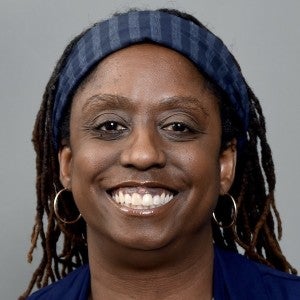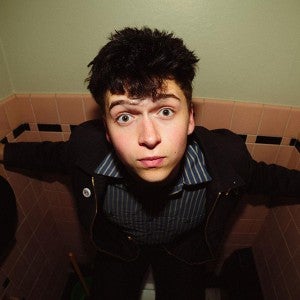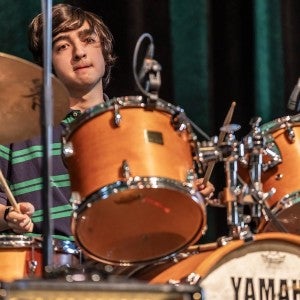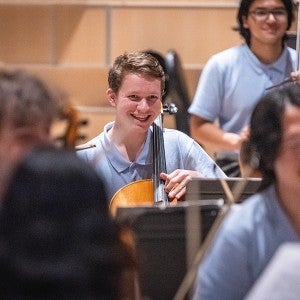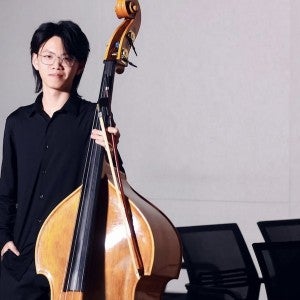Marc Lacuesta: Teaching sound judgement
A semester into his new role as Director of Music Production and Engineering, Marc Lacuesta opens up about life at Interlochen.

When I announced that I had been hired as Director of Music Production and Engineering at Interlochen Center for the Arts, the response was overwhelmingly positive. Everyone, regardless of who I heard from, reiterated the same sentiment—Interlochen is a special place.
I knew that already. I looked through the sizable list of accomplished alumni and daydreamed about going to school here—being tackled by my roommate Terry Crews years before his national commercials as the office linebacker while on my way to a songwriting class where I sat next to my two besties: Jewel and Josh Groban. And as I read through these impressive alumni lists, I also started to wonder what it was about the Interlochen experience that made it transformative for so many people.
As a recording engineer and producer in Nashville, I had worked with a number of Interlochen alumni. I wanted to hear straight from the source about what made Interlochen such a unique place, so I reached out to the alumni I knew, and asked them to describe their time in the woods. They all mentioned the exact same things: A tight-knit community, an extreme dedication to the arts, a concrete connection to Interlochen’s storied history… and snow. Lots and lots of snow.
I recently completed my first semester as an educator at Interlochen, and I’ve already seen and experienced all of these things. In the Music Center, I was quickly embraced by my coworkers and respected by my students. I took two campus tours with Margaret Beery where she told me all about the history of Interlochen, the generosity of numerous benefactors, and the tenacity of Joe Maddy. And a few days into November, I experienced a winter storm that dumped over 20 inches of snow on my doorstep in under 24 hours.
During one of the last few weeks of my first semester, I finished a class and dismissed my students for lunch, but they all stayed seated and continued to work on a project that I had given them. I left them in class and went to lunch extremely impressed with their work ethic. After telling a colleague in the Music Department about the class, she jovially replied, “Welcome to Interlochen.” She wasn’t surprised at all. Rather, she expected that dedication. And now, after getting to know these kids, and with a few classes under my belt, I expect it as well.
I’m proud to be a part of Interlochen, and I look forward to continuing its indisputable reputation for excellence and dedication. I’m equally proud to add my new curriculum to the school’s offerings.
In the following paragraphs, I’ll explain how I’m developing my curriculum, as well as how my colleagues and I are outfitting the Music Center student teaching studio with the right gear and equipment to meet our educational and artistic needs.
Space and gear
One of my first responsibilities after starting my tenure at Interlochen was to outfit the recording studio of the newly completed, 62,000 square-foot Music Center with hardware and software that Interlochen students would see in professional recording situations. I wanted the students to work with gear that was similar, and in most cases, identical to the type of equipment that they would see in the real world.
If you’re not a professional audio gearhead, skip to the next paragraph before your eyes roll into the back of your head. And for those of you who are gearheads, I’ll briefly mention that we’ve outfitted the studio with some classic gear: the LA2A and 1176 compressors, a pair of Distressors, API and Neve preamplifiers and EQs, some Lexicon reverbs and delays, as well as Neumann, Peluso, Shure, and Oktava microphones. The studio is also outfitted with Pro Tools and Logic.
Each piece of gear was chosen for a specific purpose. Some gear was chosen for its warmth, while other gear was chosen for its accuracy. Some gear was chosen because it is flexible, and applicable to many different situations. And some of the other gear may only be appropriate for one purpose, but it does that one thing very, very well.
Every one of my students this year is also a composer and arranger, each with their own distinct sound and style. It’s uncommon at this age to already have a vision of the kind of art that one wishes to create; the process of discovering one’s artistic vision usually involves years of experimentation and self-reflection. I’m lucky that this year’s students have already created quite a bit of music of their own, and already identify with their brand of art.
Because they have a clear vision about their art, I can focus more of this year’s teaching energy on the technical side of the major. For example, one of my main goals this year is to teach my students how to choose the right gear for the right project. Some microphones and preamps color the sound in a specific way and give it a specific character, while other preamps and microphones are very transparent. Some compressors can smooth out a recording, while others can make it sound more aggressive. I want to help my students create the sounds that they imagine in their head, to match the aesthetic that they have in mind.
Most of my students came to Interlochen with a decent understanding of computer recording and mixing basics. Many of them have been producing and mixing for years. In some cases, they’ve bought very specific software to achieve one very specific audio effect. But if I ask them to explain why this specific effect works in regard to a specific song, or how to recreate the effect with simple tools and software that they already own, but they can’t. Although my students already have experience recording and programming music, there are gaps in their knowledge, and that’s why I’m here—to help fill in those gaps.
Curriculum
I want Interlochen’s recording engineers and producers to know the basics. They are at the very beginning of their careers, and having a solid foundation in the basics of audio recording will make future learning much easier. I also want my students to be interested in the history of audio production as well. Every week, the students in my seminar class report on one of their favorite producers, and we listen to numerous musical examples from their career.
Hands-on experience, friendly competition, and peer critique are important to me, and my curriculum demonstrates that. In my Fundamentals of Mixing class, I pick out a song that showcases whatever we covered in class that week, and all nine students mix the same song. I choose the piece of work that sounds the most polished and complete, and I play the winning mix for the class so we can discuss its merits and shortcomings. It’s not awkward discussing the shortcomings of the mix, because it has already been recognized as the best mix of the class. At the end of the year, the mix engineer with the most wins will receive a gift certificate to the Melody Freeze.
In addition to in-class and studio assignments, my students have been spending time recording a number of student ensembles. We’ve recorded jazz ensembles, the composition majors concert, and a large number of student and faculty recitals. This is a key learning opportunity for the students. They have to set up and break down the session on their own. They have to schedule their time wisely. They have to consider where they’re recording and what is being played, the placement of their gear, and how it will impact the way the piece sounds. And most importantly, their work will be unofficially judged by their peers and their reputations will be built.
When my students have collected enough quality content, we will take our recordings to our friends at Interlochen Public Radio, who have offered to help us produce an on-air series based on their work. This is an amazing opportunity for many of these students to earn their first professional recording and production credits with a nationally recognized, award-winning public radio station.
--Marc Lacuesta
Learn more about our Music Production & Engineering programs at Arts Camp and Arts Academy.

